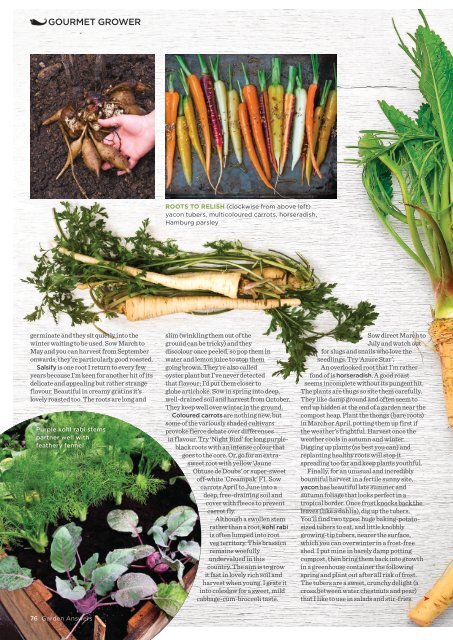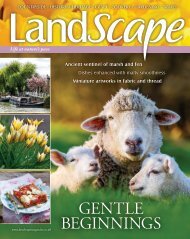You also want an ePaper? Increase the reach of your titles
YUMPU automatically turns print PDFs into web optimized ePapers that Google loves.
gourmet grower<br />
Roots to relish (clockwise from above left)<br />
yacon tubers, multicoloured carrots, horseradish,<br />
Hamburg parsley<br />
germinate and they sit quietly into the<br />
winter waiting to be used. Sow <strong>March</strong> to<br />
May and you can harvest from September<br />
onwards; they’re particularly good roasted.<br />
Salsify is one root I return to every few<br />
years because I’m keen for another hit of its<br />
delicate and appealing but rather strange<br />
flavour. Beautiful in creamy gratins it’s<br />
lovely roasted too. The roots are long and<br />
Purple kohl rabi stems<br />
partner well with<br />
feathery fennel<br />
slim (winkling them out of the<br />
ground can be tricky) and they<br />
discolour once peeled, so pop them in<br />
water and lemon juice to stop them<br />
going brown. They’re also called<br />
oyster plant but I’ve never detected<br />
that flavour; I’d put them closer to<br />
globe artichoke. Sow in spring into deep,<br />
well-drained soil and harvest from October.<br />
They keep well over winter in the ground.<br />
Coloured carrots are nothing new, but<br />
some of the variously shaded cultivars<br />
provoke fierce debate over differences<br />
in flavour. Try ‘Night Bird’ for long purpleblack<br />
roots with an intense colour that<br />
goes to the core. Or, go for an extrasweet<br />
root with yellow ‘Jaune<br />
Obtuse de Doubs’ or super-sweet<br />
off-white ‘Creampak’ F1. Sow<br />
carrots April to June into a<br />
deep, free-draining soil and<br />
cover with fleece to prevent<br />
carrot f ly.<br />
Although a swollen stem<br />
rather than a root, kohl rabi<br />
is often lumped into root<br />
veg territory. This brassica<br />
remains woefully<br />
undervalued in this<br />
country. The aim is to grow<br />
it fast in lovely rich soil and<br />
harvest when young. I grate it<br />
into coleslaw for a sweet, mild<br />
cabbage-cum-broccoli taste.<br />
Sow direct <strong>March</strong> to<br />
July and watch out<br />
for slugs and snails who love the<br />
seedlings. Try ‘Azure Star’.<br />
An overlooked root that I’m rather<br />
fond of is horseradish. A good roast<br />
seems incomplete without its pungent hit.<br />
The plants are thugs so site them carefully.<br />
They like damp ground and often seem to<br />
end up hidden at the end of a garden near the<br />
compost heap. Plant the thongs (bare roots)<br />
in <strong>March</strong> or April, potting them up first if<br />
the weather’s frightful. Harvest once the<br />
weather cools in autumn and winter.<br />
Digging up plants (as best you can) and<br />
replanting healthy roots will stop it<br />
spreading too far and keep plants youthful.<br />
Finally, for an unusual and incredibly<br />
bountiful harvest in a fertile sunny site,<br />
yacon has beautiful late summer and<br />
autumn foliage that looks perfect in a<br />
tropical border. Once frost knocks back the<br />
leaves (like a dahlia), dig up the tubers.<br />
You’ll find two types: huge baking-potatosized<br />
tubers to eat, and little knobbly<br />
growing-tip tubers, nearer the surface,<br />
which you can overwinter in a frost-free<br />
shed. I put mine in barely damp potting<br />
compost, then bring them back into growth<br />
in a greenhouse container the following<br />
spring and plant out after all risk of frost.<br />
The tubers are a sweet, crunchy delight (a<br />
cross between water chestnuts and pear)<br />
that I like to use in salads and stir-fries. ➤<br />
76 <strong>Garden</strong> <strong>Answers</strong>
















